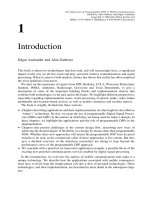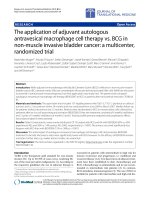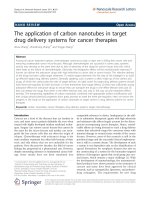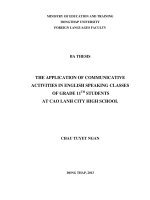RESEARCHING THE APPLICATION OF RETROPERITONEOSCOPIC SURGERY IN TREATMENT OF URETEROPELVIC JUNCTION OBSTRUCTION IN UNDER 5 YEAR OLD CHILDREN
Bạn đang xem bản rút gọn của tài liệu. Xem và tải ngay bản đầy đủ của tài liệu tại đây (201.46 KB, 27 trang )
MINISTRY
MINISTRY
OF EDUCATION AND TRANING
OF NATIONAL DEFENCE
MILITARY MEDICAL UNIVERSITY
NGUYỄN THỊ MAI THỦY
RESEARCHING THE APPLICATION OF
RETROPERITONEOSCOPIC SURGERY IN TREATMENT
OF URETEROPELVIC JUNCTION OBSTRUCTION IN
UNDER-5-YEAR-OLD CHILDREN
Major : Kidney and Urology Surgery
Code : 62 72 01 26
ABSTRACT OF MEDICAL PhD. THESIS
HANOI – 2015
THIS WORK IS COMPLETED IN Military Medical
University
Scientific Supervisor: Prof. PhD. Nguyen Thanh Liem
Opponent 1: Prof. PhD. Tran Ngoc Sinh
Opponent 2 : Associate Prof. PhD. Le Ngoc Tu
Opponent 2 : Associate Prof. PhD. Trần Văn Hinh
The dissertation will be defended in the presence of School-level
Board of Examiners
At …., date ….month….year ….
This thesis may be found in:
1. National Library
2. Library of the Military Medical University
LIST OF RESEARCH WORKS IN RELATION TO THE
AUTHOR’S DISSERTATION
1.
Nguyễn Thị Mai Thủy, Nguyễn Thanh Liêm (2014),
"Retroperitoneal one trocar assisted laparoscopy to treat
congenital ureteropelvic junction obstruction by AndersonHvnes technique in children", Vietnam Medicine, 423, pp. 8-12.
2.
Nguyễn Thị Mai Thủy, Nguyễn Thanh Liêm (2015),
“Assessing the treatment results of ureteropelvic junction
obstruction in under-5-year-old children by 1 trocar assisted
retroperitoneoscopy, Vietnam Medicine, 433. pp. 15-19.
1
INTRODUCTION
1. Introduction
Ureteropelvic junction is the connecting part between the
renal pelvis and ureter. Ureteropelvic Junction Obstruction is the
most common disease in the birth defects causing hydronephrosis in
children. By the advancement of prenatal diagnosis, the disease is
increasingly being diagnosed and early treated. Anderson-Hynes
surgery is a surgery to have the best treatment results in children with
a success rate of more than 95%.
Endoscopic surgery shall have treatment results equivalent to
the classic open surgery. However, this technique is highly required
with surgical instruments as well as qualification of the surgeon. The
operative time is prolonged, especially in small children. To shorten
the operative time, some authors have proposed to use retroperitoneal
support endoscopy 1 trocar to dissect the junction and put it out to
suture. This method takes maximum advantage of the benefits of the
endoscopic surgery and open surgery. In our country, the application
of retroperitoneoscopic assisted, as well as evaluating the safety and
efficacy of this surgery in under-5-year-old children is still a question
for the pediatric urologist. Therefore, we have conducted this
research for 2 purpose:
1. Researching to apply the technique of 1 trocar assisted
retroperitoneoscopy in treatment of ureteropelvic junction
obstruction in under-5-year-old children at National Hospital
of Pediatrics.
2. Assessing treatment results of 1 trocar assisted
retroperitoneoscopy in treatment of ureteropelvic junction
obstruction in under-5-year-old children at National Hospital
of Pediatrics.
2. Title necessity
The disease as ureteropelvic junction obstruction is common
disease in the birth defects causing hydronephrosis in children.
Previously, the open shaping surgery for ureteropelvic junction
according to Anderson-Hynes method is the gold standard in
2
treatment. The application of endoscopic surgery is conducted at
National Hospital of Pediatrics since 2007. By the advancement of
prenatal diagnosis, the surgical age is increasingly reduced. However,
due to the limited operation field, the operative time in children is
prolonged. The research of applying retroperitoneoscopic support
surgery 1 trocar and assessing treatment results of this technique to
reduce the operative time is very essential.
3. New contributions to the thesis
- Researching to apply the technique of 1 trocar assisted
retroperitoneoscopy in treatment of ureteropelvic junction obstruction
in under-5-year-old children at National Hospital of Pediatrics.
- Assessing treatment results of 1 trocar assisted
retroperitoneoscopy in treatment of ureteropelvic junction obstruction
in under-5-year-old children at National Hospital of Pediatrics.
4. Layout of the thesis
This thesis consists of 126 pages including 2 Parts and 4 Chapters:
Introduction and objective of research 2 pages, overview 36 pages,
object and methods of research 23 pages, results 27 pages, discussion
34 pages, conclusion and recommendation 3 pages. There are 42
tables, 2 diagrams, 28 figures and 93 references in the dissertation
(12 versions in Vietnamese and 82 versions in English, 1 versions in
German).
Chapter 1
OVERVIEW
1.1 Embryonic summary, surgical involvement of kidney and
ureter
1.1.1. Embryology of kidneys and ureter: kidney is formed from 2
intermediate mesoderm strips. The ureteropelvic junction is formed
from the 5th week of pregnancy. Abnormal development of the
kidney and ureter may cause the congenital urinary malformation in
children.
1.1.2. Surgical involvement of kidney and ureter: kidney and
ureter is in retroperitoneal in Gerota fascia, relating to the organs in
3
the abdomen and the inferior and posterior abdominal muscles.
1.2. Physiology on urinary excretion phenomenon, causes,
pathogenesis of ureteropelvic junction obstruction
1.2.l. Urinary excretion: the urine after forming will be excreted
from the calyces, renal pelvis, ureteropelvic junction, ureter, to the
vesica under 1 pm due to the steady contraction of the renal pelvis,
junction, ureter.
1.2.2. Urine circulation when obstructing the junction: The urine
circulates through the junction in principle of Koff, causing the
stretching calyces, renal pelvis.
1.2.3. Causes: The internal cause of ureter: hypoplastic, junction
hypertrophy, mucosal folds; external causes: lower polar arteries,
ligament.
1.3. Diagnosis of hydronephrosis due to ureteropelvic junction
obstruction
1.3.1. Clinical characteristics: in children, the symptoms are usually
poor, may have abdominal pain, urinary infection, possible neprauxe
touching.
1.3.2. Imaging diagnosis methodologies for the disease as
ureteropelvic junction obstruction
1.3.2.1. Prenatal ultrasound: Graded according to the Society for
Fetal Urology (SFU), with prognostic value of disease after giving
birth.
1.3.2.2. Postnatal ultrasound: Diagnosing the hydronephrosis due to
ureteropelvic junction obstruction and determining the urologic
defects if any to propose the treatment direction.
1.3.2.3. Urographie intraveineuse (UIV): as the common diagnostic
surveying method. There are 4 grades of hydronephrosis (Valeyer
and Cendron).
1.3.2.4. Radioisotopegraphy: very valuable to diagnose obstruction
in the junction and kidney function.
1.3.2.5. Other Imaging diagnosis: Tomography (CT), magnetic
resonance imaging (MRI), urinary bladder scanning.
4
1.4. Pyeloplasty surgery treatment for ureteropelvic junction
obstruction
1.4.1. Indication of pyeloplasty surgery
ureteropelvic junction obstruction in children.
treatment
for
- With clinical symptoms: abdominal pain, possible neprauxe
touching, urinary infection.
- With anterior and posterior diameter of the renal pelvis by more
than 20mm.
- Ureteropelvic
exploration.
junction
obstruction
in
imaging
diagnosis
- The hydronephrosis condition is not improved or worse.
1.4.2. Pyeloplasty
obstruction
techniques
for
ureteropelvic
junction
1.4.2.1. Non-disconnection techniques: Shaping Y-V (Foley), using
rotation flap of renal pelvis (Culp and De Weerd).
1.4.2.2. Disconnection techniques: Anderson-Hynes surgery, basing
on the principle of dividing into renal pelvis, removing the diseased
junction and forming the new junction.
1.4.2.3. Selection of plastic techniques: Anderson-Hynes surgery is
preferred to select due to the high success rate.
1.4.3. Accessing lines used in plastic surgery for treatment of
ureteropelvic junction obstruction
1.4.3.l. Open operative surgery: horizontal line under ribs, back
line, back-slope line.
1.4.3.2. Laparoscopic surgery: Having advantages of "miniinvasive" feature. The laparoscopic surgery may be used through the
peritoneum or retroperitoneal. Results are equivalent. However, the
operative time is prolonged and difficult for small children.
l.4.3.3. 1 trocar assisted retroperitoneoscopic: Only putting 1
trocar with 2 channels, using the retroperitoneal laparoscopic method
for dissection and put the junction out of the abdomen through the
trocar site to suture. The advantage is to shorten operation time,
suitable for the small children.
5
1.4.3.4. Laparoscopic pyeloplasty for ureteropelvic junction with
the help of robots: as the expertise, expensive and not-widelyapplied technique.
1.4.4. Interventional urologic endoscopy: Indicated with restriction
in children. The treatment result is lower than surgery.
1.5. Domestic research situation: There had few reports on the
application of laparoscopic surgery and assessing the results of
treatment of the disease as ureteropelvic junction obstruction in
children.
Chapter 2
OBJECT AND METHODS OF RESEARCH
2.1. Object of reseach:
2.1.1. Criteria to select patients in the research
The selected patients in the research must have full standards as
follow:
- Age:
From birth to <5 years old.
- Sex: men and women without distinction.
- Having full medical records with clinical data, diagnostic
imaging, laboratory tests.
- Being diagnosed to be hydronephrosis due to congenital
ureteropelvic junction obstruction at National Hospital of Pediatrics
and being indicated for plastic surgery for ureteropelvic junction.
- The patients’ families voluntarily agree to have a surgery.
Indication for plastic surgery:
+ Ultrasound: inferior and posterior diameter of the renal pelvis by
more than 20mm.
+ The image surveys confirms the hydronephrosis due to ureteropelvic
junction obstruction: UIV showed the hydronephrosis at level I, level II,
or level III. Renal scanning found the obstruct in urine excretion via the
ureteropelvic junction, with kidney function > 20%.
6
2.1.2. Exclusive criteria from the research
- Patients over 5 years old.
- Patients with secondary ureteropelvic junction obstruction.
- Patients with hydronephrosis on 2 sides and being indicated for
surgery for two kidneys
- Patients with drainage-surgery or ureteropelvic shaping but failed.
- Patients with pyelectasis over 50mm, or, less than 20% of renal
function on renal scanning.
- The patients’ families disagree to have a surgery or inadequate
medical records.
2.2. Methods of research
2.2.1. Research design: Designed according to prospective
descriptive research with intervention. Evaluation factors are the
success rate of endoscopic surgery in treatment of ureteropelvic
junction obstruction.
2.2.2. Sample size
Population in selection of researching sample size: as all the patients
under 5 years old examined at National Hospital of Pediatrics and
was diagnosed with hydronephrosis due to ureteropelvic junction
obstruction, with indication of pyeloplasty surgery for the
ureteropelvic junction obstruction by 1 trocar assisted
retroperitoneoscopy, between January 2011 to June 2013.
2.3. Way of research conduct:
Eligible patients to be selected to the research will be in the preset
form. The order of the conducting steps as follows:
2.3.l. Pre-surgery research criteria
2.3.1.1. Clinically: Age, gender, side of surgery, weight, onset
symptom, functional and entity symptoms.
2.3.1.2. Imaging surveys:
- Ultrasound for inferior and posterior diameter of the renal pelvis,
thickness of renal parenchyma
- Taking UIV
7
- Taking renal scanning
- Taking a retrograde urethral bladder
- Taking MRI urinary system
2.3.1.3. Tests: Blood test, urine test.
2.3.2. Research criteria in surgery
2.3.2.1. Surgical Procedures
Preparation of patients: Enema, fasting 6 hours before surgery.
Anesthesia: intubation, epidural anesthesia for pain relief during
surgery and after surgery.
Instruments:
- Conventional abdominal surgical endoscope set branded Karl-Storz;
Stryker.
- 1 trocar retroperitoneal in type of ball-pumping at the top.
- 1 optique 0°, with a channel to put endoscopic surgical instruments
5 mm.
- Instrument for laparoscopic surgery: instruments 5mm branded
Karl-Storz for dissection consists laparoscopic tampon, Kelly
laparoscopic dissection clamp, unipolar electric laparoscopic hook.
- Open surgical instruments in pediatric urology.
- JJ catheter.
The steps taken:
- Conducting the skin incision 5cm long below the rib No. 12
- Creating retroperitoneal cavity, put trocar.
- Dissection of the ureteropelvic junction
- Taking the junction out of the abdominal wall over placement of
trocar.
- Shaping the ureteropelvic junction in principle of Anderson-Hynes
method. Setting JJ catheter.
- Putting the junction into the abdomen.
2.3.2.2. Research criteria in surgery: Operative time, inflatable
8
time, hurt in the operation: the ureter, renal pelvis, junction,
combination hurt. Cause of conversion of open surgery. Taking the
junction out of the placement of trocar for convenient shaping. It
must make a wide incision for the placement of trocar for which
reason. The surgical complications, if any.
2.3.3. Postoperative research criteria
2.3.3.1. During hospitalization: length of hospital stay, calamities
and complications such as bleeding, infection, leakage of
connecting opening.
2.3.3.2. After discharge: Results may be evaluated postoperatively
at least 6 months: based on clinical, ultrasound, exploration and
evaluation of renal function may be performed when posterior and
anterior diameter of the renal pelvis by 15mm: taking UIV, and, or
renal scanning.
We divided the surgery results into 2 types:
+ Good result
. Clinically asymptomatic, not palpable kidneys as examination
. Renal ultrasound shows clear improvement, thickness of renal
parenchyma increased.
When taking UIV and, or renal scanning:
. Taking UIV, it is found that the drug excretion from the renal pelvis
to the ureter has been improved.
. Renal scanning showed the ability of radiation catching, Tmax, time
of drug release has been improved compared with pre-surgery.
+ Bad type: Forced to have intervention by surgery.
. Clinically, there had symptoms as abdominal pain, urinary
infection, large kidney as taking abdominal examination.
. Ultrasound: The inferior and posterior diameter increased, the
thickness of renal parenchyma reduced.
. Taking a vein urinary map may find that the renal pelvis larger
stretched than before surgery.
. Renal scanning: kidney function reduced
9
2.4. Data management and processing
Collected data is recorded under form of researching medical record
(Appendix 1) and processed by using software STATA 10.
CHAPTER 3
RESEARCH RESULTS
70 (seventy) patients under 5 years old underwent retroperitoneal
laparoscopic dismembered pyeloplasty using 01 trocar from 01/2011
to 06/2013.
3.1. Characteristics of the research objects
Average ages: 22.6 ± 18.6 months old, smallest age: 1 month, oldest
age: 5 years old, 65.71% of patients under 2 years old.
Sex: 65 males and 5 females.
Average weight: 10.6 ± 3.8 kg, the lightest weight: 3.5 kg; the
heaviest weight: 19 kg.
3.2. Clinical and subclinical characteristics
3.2.1. Clinical characteristics
35/70 (50%) patients have been undergone a prenatal diagnosis. The
rate of prenatal diagnosis in the group of patients under 12 months
old was 23/28 (82.14%). 49/70 (70%) patients have expressed no
clinical symptoms. 50% of the patients had a hydronephrosis on the
basis of clinical symptoms, the patients whose size of Renal pelvis is
larger than 35mm (p<0.05) were often suffered from the
hydronephrosis.
3.2.2. Subclinical
diagnosis
characteristics
of
preoperative
imaging
3.2.2.1. Ultrasonography: 100% of patients have been undergone
preoperative ultrasonography. The mean size of Renal pelvis was:
34.3 ± 8.1 mm. 43/70 (61.43%) patients had Renal pelvis under
35mm. Size of Renal pelvis among the group of ages had no
difference. Thickness of renal parenchyma: 4.2 ± 1.0 mm; the
thinnest renal parenchyma: 2.5 mm, and the thickest renal
parenchyma: 7mm. The percentage of patients whose the thickness of
10
renal parenchyma were under 5 mm was 68.57%, and The percentage
of patients whose the thickness of renal parenchyma were under 3
mm was 5.71%.
3.2.2.2. Urographie intraveineuse (UIV): 34/70 (48.6%) of patients
has undergone UIV before surgery. Hydronephrosis level 1: 8/34
(23.53%) of patients; Hydronephrosis level 2: 23/34 (67.65%) of
patients; Hydronephrosis level 3: 3/34 (8.82%) of patients.
3.2.2.3. Voiding cystourethrogram – VCUG: 50/70 (71.4%)
patients underwent Voiding cystourethrogram – VCUG before
surgery. There were only 1 patient with vesical - ureteral reflux level
1, whose UIV film has not found an a sign of ureteral dilatation.
3.2.2.4. Magnetic Resonance Imaging – MRI: 38/70 (54.3%)
patients underwent Magnetic resonance imaging (MRI) for assessing
the urinary system before surgery.
3.2.2.5. Renal scintigraphy: 56/70 (80%) patients have been
undergone Renal scintigraphy before surgery. There were differences
in renal functions between the patients who were suffered from
dilatation of kidney over 35 mm and those who were suffered from
dilatation of kidney under 35 mm.
Table 3.17. Renal functions and size of Renal pelvis before surgery
Rental
functions
Size of Renal pelvis
Under 35
mm
Over 35 mm
< 40%
4 (12.12%)
6 (26.09%)
40 – 50%
7 (21.21%)
>
50%
P
22 (66.67%)
10 43.48%)
7 (30.43%)
<0.05
Total (n)
10
17
29
56 (100%)
We has not found a common evacuation curve. All the curves
expressed in the renal scans reflected the actual situation of
ureteropelvic junction obstruction pyeloplasty (UPJO), the most
common type of graph is the type of accumulation graph. 36/56
(64.29%) patients had accumulative evacuation curve of urine. 20/56
11
(35.71%) patients had graphs in the form of slow Urinary Excretion.
3.3. Some characteristics during surgery
2 patients out of 70 patients have undergone open surgery due to
peritoneal penetration. 68 patients have undergone retroperitoneal
laparoscopic dismembered pyeloplasty using 01 trocar. The results of
assessment during and after surgery were based on the results of such
68 patients.
The average time of surgery was 74.8 ± 15.2 minutes. The shortest
time of surgery was 45 minutes, and the slowest time of surgery was
100 minutes. The average time of ejector was 19.7 ± 5.8 minutes.
2/27 (2.86%) patients were suffered from peritoneal penetration.
62/68 (91.2%) patients are brought the connection part between
Renal pelvis and Ureter outside their abdominal wall and underwent
a retroperitoneal laparoscopic dismembered pyeloplasty using 01
trocar. 6/68 (8.8%) patients had enlarged the cutting line at the
bottom of the trocar because it was difficult to take the connection
part out the abdominal wall (4 patients were suffered from
pyelonephritis and 4 patients were not put JJ Urethral catheter).
There were differences in the cutting line at the bottom of the trocar
between the patients who were suffered from pyelonephritis and
those who were not suffered from pyelonephritis during taking the
connection part out the abdominal wall (p<0.05).
There were differences in Urinalysis for finding hemoleukocyte
between the patients who were suffered from pyelonephritis and
those who were not suffered from pyelonephritis.
Table 3.22. Urinalysis and characteristicsi of Renal pelvis during
surgery (n = 68)
Characteristic of
Renal pelvis
Urinalysis for finding
hemoleukocyte
Total (n)
Negative
(n = 57)
Positive
( n = 11)
Pyelonephritis
2 (3.51%)
3 (27.27%)
5
Thin wall
55 (96.49%)
8 (72.73%)
63
12
P
< 0.05
68 (100%)
There was no difference in time of surgery among the groups of age.
3.4. Assessing results of treatment outcomes after surgery
The average time of hospitalization was 3.7 ± 2.6 days, the shortest
time was 1 day, and the longest time was 15 days. After surgery,
58/68 (85.29%) of patients had normal development. None patient
was suffered from Surgical Site Infection (SSI), none was bled, none
was suffered from urine leakage after surgery. 13/68 patients were
hospitalized during over 4 days. 613 (46.15%) patients were suffered
from hematuria but were not necessary to give a blood transfusion.
Table 3.29. Outcomes during the hospitalization (n = 68)
Outcomes
N
%
Normal
58
85.29
Fever, hematuria
4
5.88
Hematuria
5
7.35
Urinary tract infection
–UTI
1
1.47
Total
68
100
3.5. Long-term results of surgery
Assessment of long-term results after surgery was based on the
results of re-examination after 6 months – 1 year upon the time of
surgery. 68 patients underwent retroperitoneal laparoscopic
dismembered pyeloplasty using 01 trocar (2 patients with open
surgery were excluded from the research). 51/58 (75.71%) patients
were monitored after 6 months upon the surgery. The average
monitoring time was 8.6 ± 1.8 months, the shortest time was 6
months and the longest time was 14 months. 17/68 (24.29%) patients
were out of touch due to wrong addresses or wrong phone numbers.
Based on the standards for assessment of re-examination results, we
divided such results into 3 groups including good, average and bad.
13
88.24% of patients obtained good results of Transverse renal pelvis
diameter, the rental functions were obviously improved after the
surgery. 7.84% of patients obtained average results when their renal
pelvis dilated more than 10mm, although there was no clinical
symptom. 3.92% of patients had to undergo re-surgery due to
anastomosis stenosis.
Table 3.33. Image survey of the monitored patients (n = 49)
Image survey
N
%
Ultrasound
49
100
UIV
20
40.82
Renal scan
32
65.31
3.5.1. Ultrasound after surgery
49 patients were performed ultrasound after surgery after 6 months to
1 year. The average size of Renal pelvis after surgery was 14.3 ± 5.1.
mm, the smallest size was 5 mm, and the largest size was 31 mm.
There were obvious differences in the size of renal pelvis compared
to the size of Renal pelvis before surgery, p < 0.05.
The average size of the thickness of renal parenchyma after surgery
was 7.8 ± 1.7 mm, the thinnest size was 5 mm and the thickest size
was 12 mm. There were obvious statistical differences in the
thickness of renal parenchyma before surgery, p < 0.05.
There were statistical differences in the size of renal pelvis after
surgery among the groups of age, p < 0.05.
3.5.2. UIV after surgery
20 patients who were being monitored were undergone UIV after
surgery. 16/20 patients were suffered from dilatation of kidney level
1. 4 patients were suffered from Hydronephrosis level 2, dilatation of
Renal pelvis, round renal calyx. During the process of UIV, we found
that the Renal pelvis was deleted but not as round as before surgery,
and saw that the image of drugs run down their Ureter.
14
Table 3.36. The size of Renal pelvis in the ultrasound after surgery
by ages (n = 49)
The size
of Renal
Ages
Total
<6
months
6 - < 12
months
12 - < 24
months
> 24
months
< 10mm
4
(57.14%)
1 (8.33%)
1 (8.33%)
2
(11.11%)
8
10 –
20mm
3
(42.86%)
10
(83.33%)
9 (75%)
15
(83.33%)
37
> 20mm
0 (0%)
1 (8.33%)
2
(16.67%)
1 (5.56%)
4
P
< 0.05
49
(100%)
3.5.3. Renal scan after surgery
32 patients underwent renal scan and were monitoring. 26 patients
underwent renal scan both before and after surgery.
The average value of renal functions after surgery on the basis of
renal scan was 51.2 ± 5.9%. No patient had their renal functions
under 40%.
During analyzing the size of renal pelvis after surgery in the form of
urinary excretion curves, we found that there were differences
between the sizes of renal pelvis in the untrasound and the urinary
excretion in the renal scan, p < 0.05. Therefore, the size of renal
pelvis in the ultrasound was an indirect information which reflected
the urine circulation through the connection part between the renal
pelvis and ureter.
Table 3.40. Sizes of renal pelvis and curve of urinary excretion after
15
surgery (n = 32)
Sizes of renal
pelvis after
> 20mm
Urinary excretion curve
Slow
Normal
Accumulation
excretion
(n = 21)
(n = 4)
(n = 7)
7
0 (0%)
0 (0%)
(33.33%)
13
7 (100%)
4 (100%)
(61.91%)
1 (4.76%)
0 (0%)
0 (0%)
P
< 0.05
< 10mm
10 – 20mm
Total
7
24
1
32
(100%)
During analyzing the differences in the size of renal pelvis in the
untrasound, Tmax in the renal scan showed the statistical differences
in the size of renal pelvis before and after surgery.
Table 3.41. Comparison of size of renal pelvis, thickness of renal
parenchyma, Tmax before and after surgery
Values for assessing
results after surgery
Before
surgery
After
surgery
Size of renal pelvis
(n = 49)
34.0 ± 7.9
mm
14.3 ± 5.1
mm
Thickness of renal
parenchyma (n =
49)
4.1 ± 1 mm
7.8 ± 1.7
mm
Tmax (n = 26)
25.7 ± 10
minutes
16 ± 5.5
minutes
P
P < 0,05
(Wilcoxon
signed-rank
test)
P < 0,05
(Wilcoxon
signed-rank
test)
P < 0,05
(Wilcoxon
signed-rank
test)
16
Chapter 4
DISCUSSION
4.1 General features of research patients
The treatment in the research is applied for the youngest patient
at age of one-month and for the oldest patient at the age of five. The
average age is 22.6 months lower than that in other authors’
researches.
The prioritized sex is male with 65 male children of 70 patients.
The pathological characteristics are prioritized on the left organ, in
which 48 of 70 (equal to 68.57%) patients had surgery on left kidney
and 22 of 70 (equal to 31.43%) patients had surgery on right kidney.
This result is consistent with the assessment.
4.2 Specification of retroperitoneal one trocar-assisted
laparoscopy to form ureter pelvic junction (UPJ)
4.2.1 Age of treatment
- The treatment age in this research is lower than previous
publications. Prenatal diagnosis plays an important role in early
diagnosis and treatment which contributes to preserve renal
functions. Mayor and Mc Crory assumed that renal functions can be
recovered with early treatment. According to Vu Le Chuyen, the
most suitable subjects of treatment are children aged from 6 to 24
months old. Our research found out that renal functions after surgery
have many differences among different ages.
- Children aged 5 years old are appropriate with retroperitoneal
one trocar-assisted laparoscopy, namely 62 of 68 (91.2%) patients
having retroperitoneal one trocar-assisted nephrectomy without large
incision. Caione operated such surgeries on five-year children and
none of which must be switched to open surgery.
4.2.2 Diagnosis and specification of treating ureter pelvic
junction (UPJ) obstruction
- Few of clinical symptoms: 70% of research patients had few
clinical symptoms. The disease was mainly discovered by prenatal
diagnosis or unintentional finding in examinations for other diseases
such as symptoms of a lower urinary tract infection (4.29%).
17
- Clinical examination with finding of large kidney in 50% of
cases among all ages and regular renal pelvis with size of over
35mm.
- Imaging probes playing a significant role in diagnosis and
therapeutic attitude.
+ Ultrasonography is one of simple, easy to implement and
highly effective procedures in diagnosis and monitoring the
developments of the disease. The entire research subjects have been
applied the ultrasound. The ultrasound is used for internal and
external diameters of renal pelvis, dilatation of the calyces and
thickness of renal parenchyma to evaluate renal hydronephrosis and
indirectly examine junction and renal functions. Prenatal ultrasound
under the categories of SFU enables to have prognosis of postnatal
disease developments and orientation for treatment. According to
Yang, 70 percent of renal hydronephrosis at level III or IV under the
categories of SFU must require postnatal surgeries. Doctor Nguyen
Viet Hoa has monitored 79 children with renal hydronephrosis due to
ureter pelvic junction obstruction through prenatal diagnosis and
found out that all subjects with renal hydronephrosis at level III or IV
had to be operated surgery within the early twelve months.
+ Renal scintigraphy: one of modern techniques, enables to
evaluate ureter pelvic junction obstruction and renal functions.
Eighty percent of research subjects have been examined by renal
scintigraphy with furosemide and found out to have the obstruction at
ureter pelvic junction with prolonged T/2 and clogging excretion
graph.
+ Urography Intravenous (UIV): Urography Intravenous has
been conducted with 48.57 percent of research subjects. The
proportion is lower than that in other domestic researches. Urography
intravenous has caused negative influences on children’s body
because patients has suffered from X-Ray and the UIV image could
not be used to gain exact assessment on the obstruction at ureter
pelvic junction, especially for children aged under 12 months.
+ Magnetic Resonance Imaging (MRI): Magnetic Resonance
Imaging has been conducted with 52.94 percent of research subjects.
This technology is considered to provide clearer images than UIV
18
image. Patients has not been injected with iopromide or suffered
from X-Ray. MRI together with UIV enables to exactly evaluate
damages, especially in young children.
- Early diagnosis based on prenatal diagnosis and examination
by postnatal ultrasonography. Fifty percent of research subjects have
been applied by prenatal diagnosis. The proportion of children aged
under 12 months applied by prenatal diagnosis has been 82.14
percent. Of patients at the treatment age of 12 to 24 months, 44.44
percent (8 of 18 patients) of patients were applied by prenatal
diagnosis, but were not examined and consulted in postnatal period.
- Specification of surgeries to form obstructed ureter pelvic
junction based imaging probes in following cases:
+ Ultrasound result: internal and external diameters of renal
pelvis reach over 20mm and the thickness of renal parenchyma
reduces.
+ Renal scintigraphy: There is obstruction of ureter pelvic
junction and failure of renal functions.
+ Other imaging probes if any: UIV or MRI images appear renal
hydronephrosis due to ureter pelvic junction obstruction.
+ Increasing renal hydronephrosis: increased size of renal pelvis,
reduced thickness of renal parenchyma and decreased renal functions
on renal scintigraphy.
4.3. Some of technical factors affecting the surgical results
- Laparoscopic surgery supports retroperitoneal 1 trocar to
shorten the surgical time in children under 5 years old: The average
surgery time is 74.8±15.2 minutes, equivalent to the study of Nguyen
Viet Hoa author on the canonical surgical time under the lower line
of the rips is 75.3±17.55 minutes. The average surgical time of
Caione is 95 minutes (70-130 minutes). Retroperitoneal laparoscopic
surgical time at children under the authors: Nguyen Thanh Liem: 142
minutes (115-180 minutes) Yeung: 143 minutes, El-Ghoneimi: 228
minutes.
- Due to the anatomical features of children, therefore, the
ureteropelvic junction can be taken out the abdominal wall easily
19
through placement of trocar (91.2%) after endoscopic dissection.
- Reclining posture 90o allows to approach easily into
retroperitoneal cavity and skin incision below the rib head 12 is the
shortest line to approach the Junction and bring it out.
- Peritonitis perforation when set trocar and make
retroperitoneal cavity is the risk factor to transfer to the open surgery:
we have 2/70 (2.85%) patients who are punctured peritonitis and
must transfer to the open surgery. The Author Caione has 2/28
patients who are punctured peritonitis and use needle for aspiration,
then still perform the endoscopy.
- The difficult factor to bring the ureteropelvic junction out is the
pyelonephritis condition and cannot place the catheter JJ. 6/68
(8.82%) patients must slit widely leg trocar.
Test with high rate of white blood cells (WBCs) in blood or
have WBCs in urine is the offer factor conclude pyelonephritis in
surgery. In surgery, we have lesions, pyelonephritis is thick and
sticky at 5/68 patients, accounting for 7.35%. In which, there are 4
patients we must widen the incision to bring the renal pelvis and
junction out. Proportion of pyelonephritis in our study is lower
than report of the author Nguyen Viet Hoa 14.57% (have 22/151
kidney). Probably, the patients in our study have the average
surgical age is 22.9 months; while in the study of the author
Nguyen Viet Hoa is 5.45.
- The renal pelvis dilates much more lasting the surgical time.
We think that the lasting time at this group of patient results from
sucking the renal pelvis flatly before bringing the abdominal wall out
and cut the renal pelvis into small in the plastic surgery. There is not
the difference of the surgical time and the group of age. The majority
of studies are found the difficulty in performing the retroperitoneal
endoscope in babies due to last the surgery, the junction is difficult.
With applying the endoscopic surgery to bring the junction out the
abdominal wall to sewing up, these difficulties have no longer and
the surgical time has no the difference among the group of age.
- Checking anastomosis after bringing it back belly to avoid
twisting the anastomosis.
20
Table 4.1. Time for laparoscopic surgery forming the junction shape
Authors
Numbers
of patients
Incision
Metzelder M.L
46
Cascio S.
38
Kojima Y.
23
Yeung C.K.
13
El-Ghoneimi
A.
Bonnard A.
22
Nguyen Viet
Hoa
Study
12
Through
Peritonaeum
Through
Peritonaeum
Through
Peritonaeum
Through
Peritonaeum
Through
Peritonaeum
Through
Peritonaeum
Through
Peritonaeum
1 trocar
retroperitoneal
22
68
Time for
surgery
(minutes)
175
100
275
143
228
219
176.8
74.8
4.4. The assessment of surgical results during the period of
hospitalization
The result assessment of 68 patients operated on for endoscopic
operations to bring renal pelvis ureter joint parts to the abdominal
walls.
- The average time of hospitalization in our research is 3.7±2.6,
with the shortest of 1 day and the longest of 15 days. Our two longest
patients’ hospitalization periods are 14 days and 15 day. These are
the cases in which we had to resort to outer drains because of
impossibility of using JI catheters. The period of hospitalization was
extended because of the clamping of pre-drawn drains. 80.88% of the
patients stayed in hospital for less than 4 days. The amount of time is
21
equivalent to those of other authors.
- The post-surgery developments during the period of
hospitalization: 58/68 (85.29%) of the patients witnessed positive
developments after their surgery. None of the patients suffered from
infection on incisions or urine leaking. Only 1 over 68 (equivalent to
1.47%) of the patients suffered from urinary bacteria contamination
(bacteria-containing urine planting). All of the patients were allowed
to eat after 6 hours of operation. The operated children were able to
walk after 1 day of operation. Paraceramol relievers were put into the
rectum within 24 hours after operation.
- The post-surgery hematuria was the factor extending the period
of hospitalization. 6 over 13 (equivalent to 46.15%) of the patients
suffered from hematuria. However, none of the cases had to be given
blood transfusion.
4.5. The result assessment after hospitalization
51 over 68 of the patients had the post-surgery patient
information with the time of result assessment from 6 months to 1
year. 17 over 68 of the patients were unable to be contacted by us due
to telephone numbers mistaking or unanswered phone calls.
Image surveys such as ultrasound, UIV scans, renal imaging
were resorted to in order to assess the operation results.
We divided the operation results into 3 different groups: very
good, good and average and bad, mostly based on the size of renal
pelvises on ultrasound and clinical symptoms. If the situation gets
worse, then the patient(s) shall be operated again.
The results were good if the size of renal pelvises were smaller
than 20mm. This group of patients consisted of 45/51 patients,
accounting for 88.24%. The average size of the renal pelvises was
larger than 20mm but the patients did not suffer from clinical
symptoms or being operated again. This group of patients consisted
of 4 patients, accounting for 7.84%. There were 2 over 51 patients
witnessing bad results, accounting for 3.92%. Both of these two
patients were then operated again due to the narrowness of tube
outlet. We carried out open operations and the reason was the tube
outlet having been twisted.
22
We could hardly see any difference when comparing the
changes in the size of renal pelvises before and after the operations
between the group with the size larger than 35mm and the group with
the size smaller than 35mm. However, there were some statistic
differences in terms of the age of the operation and the shrinking of
renal pelvises. Though the size of the renal pelvises before operation
may be stretched, timely intervention can help the kidneys recover
completely after operation. The age of operation is an important
factor affecting the operation results.
32 over 49 of the monitored patients were given renal imaging.
There were 26 patients given renal imaging before and after
operation.
We could hardly see any difference in terms of the renal
performance after operation in groups of renal functions before
operation, p>0.05, which meant that the renal performance can
completely recover if the factor causing obstruction is dealt with.
There was a correlative relationship between the size of renal
pelvises after operation on ultrasound and excretion of urine shown
in the excretion curve, which meant that the size of renal pelvises on
ultrasound is an extremely important factor to the circulation of urine
through joint parts.
When studying the size of renal pelvises after operation and
types of excretion curves, we realized that there were some statistic
differences p<0.05. In other words, the smaller the renal pelvises
were, the better the excretion of urine was. The size of the renal
pelvises after operation on ultrasound is an indirect factor reflecting
the actual situation of urine excretion from renal pelvis to ureter. In
terms of clinically practical aspects, we realized that because the size
of renal pelvises on ultrasound reflected the circulation of urine
through joint parts, this survey could serve as a significant basis to
assess the results of the operation.









